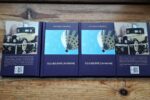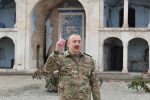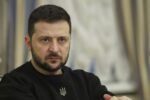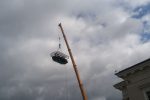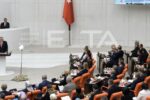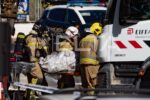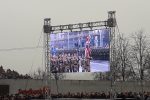Association for Asian studies “Sri Aurobindo kultūros židinys”
Vilnius, LITHUANIAT
In this article, the condition of cultural heritage in the Upper Garabagh after the armed conflict in 1988 between Armenia and Azerbaijan has been discussed. The survey shows the role of Shusha as a cultural cradle of Azerbaijan. From the given data, there is evident that in occupied territories of the country an outward as well as incorporeal heritage, i. e. architecture, art, music and literature suffered heavy injuries. The loss of the region inflicted humanitarian catastrophe and ruined the continuity of long-lasting tradition. The conclusion has been made, that destruction of local monuments and artefacts does great harm for the state of Azerbaijan. Restitution of the Upper Garabagh is one of the main questions of the day, because every nation has a right to use its heritage freely.
Keywords: Upper Garabagh, destruction, culture, heritage, law.
Introduction
From the middle of the 20th century to this day with the end of the Cold War humanity faces new grave wars and military conflicts, which in the beginning of the 21st century only grow in scale and means. Many human rights organizations register demolitions and human losses in the Middle East as well as in occupied Crimea peninsula (Ukraine), injured parts of former Soviet Union Republics Georgia, Moldova, or autonomic regions like Chechnya, not to mention earlier ethnic and religious wars in Balkans, conflicts between India and Pakistan, Israel and Palestine, or situation in Afrika. The Upper Garabagh is one of such violent points in a map of the world. Military acts produce severe damages to the people and environment, unleash millions of refugees, and the whole international life turn into tense, unsafe and timeless field of battle.
Beside human victims, the entire layers of historical and cultural legacy suffer extinction. In a modern global world-view and with the rapid progress of technical revolution we can see that question of Upper Garabagh esquires a new dimension and importance.
Though the “Nagorno Karabach issue” has roots in the 18th century, and in 1923, when NKAO was established, Shusha, Khankandi and 115 villages in Shusha district, 52 villages in Javanshir district, 30 villages in Garyagin district, and Galadarasi from Gubadli district were included in NKAO[1], only after December 1, 1988, when Armenian Soviet Social Republic adopted the decision joining the NKAO to the Armenia SSR, the most violent changes started. The scale of destruction in the Upper Garabagh considering cruel genocide against Azerbaijanis and other peaceful population, 1 million refugees, expropriation of wealth, homes and lands, and almost total demolition of buildings can be compared with those which took place in Palmyra or Allepo (Syria).
In his speech at the opening of the “4th Islamic Solidarity Games, Baku 2017” on the 10th of May, President of the Republic of Azerbaijan Ilham Aliyev said:
“The UN and OIC resolutions, which clearly recognize Armenia as an aggressor, must be the main message to all Muslim countries that want to develop relations with invader because Armenia’s policy of occupation is an attack not only on Azerbaijan’s religious and cultural assets, but on historic and cultural legacy of Islam in general. Hundreds of Islamic culture monuments, mosques, temples, cemeteries, etc. were destroyed in the territories occupied by Armenia, and all this was confirmed by the OSCE fact-finding missions. I also have to note that Pakistan and Saudi Arabia refused to officially recognize Armenia because of its occupation of the Azerbaijani territories, while Turkey has not established any relations with this country. Currently five Muslim states have officially recognized Khojaly genocide. We consider all this as an example of brotherly relationship and real support.”[2]
To the problem of security was dedicated another big event – the “4th World Forum on Intercultural Dialogue, Baku 4-6 May 2017”. For the first time, heads of more than 25 international organizations participated in the forum, joint high-level meeting of the heads of these organizations and 40 sessions and events took place. “The people of Azerbaijan make significant contributions to the traditions of tolerance at worldwide level, to develop and popularize the traditions of multiculturalism”, President Ilham Aliyev stressed in an opening speech on the 5th of May.[3] Indeed, in a light of the Upper Garabagh conflict we can wonder at the patience, diplomacy and integrity of the nation. The provisions of the international agreements on the topic are being strictly followed, and many efforts made on the highest levels to solve this problem. Azerbaijan is opening itself to the world with a peace offer, but requires the same honesty from other countries. Culture is more and more recognized as a powerful mean for this task. The core of such understanding didn’t change in UNESCO’s program since 1945. “This is not a ‘clash of civilizations’. This is a clash between those who do not believe that we can live together, and those who believe that we can. […] Safeguarding culture is far more than a cultural issue today – this is about peace-building”.[4]
Still until present day the problem has not been solved. That means, that it calls for different point of view from the side of international community.
Reasons of cul-de-sac regarding Upper Garabagh conflict
After the World War II Stalin tried to occupy a part of Turkey and called it “Western Armenia”, and Upper Garabagh was presented to the society of Armenians as a key issue for the action. When the plans did not come true, Stalin invented compensation for wounded feelings of Armenians on an account of humiliated Azerbaijani minorities in Armenia. That way the theme of famous deportations was raised, and during Soviet time there have been two large-scale deportations of Azerbaijanis (1948-1953, 1988-1993).[5] From that time, Armenian expansionism grew in scale and fulcrum. As stepping-stones served petition of 45 000 “workers” from NKAO to the Soviet government in which they complained about bad economic and cultural conditions, the strait request from Yerevan “to give back to Armenia Nakhchivan and Upper Garabagh”,[6] removing of Heydar Aliyev from the high position in Soviet cabinet of Ministry in 1987 by Mikhail Gorbachev, setting up of the “Karabach” committee and so on. To this end helped propaganda campaign, formation of negative opinion about Azerbaijan, even armed provocations and terrorist attacks. In the eyes of the world Armenia became a victim, not an aggressor, and in the process of negotiations both sides seem standing on the same level.[7] Even more, the manipulation with the so-called “Armenian genocide”, supposedly executed during Ottoman State times, plays decisive role in making decisions on an international basis. Nevertheless, such historians as Musa Gasimli pay attention to the necessity to scrutinize real facts: “The falsification of historical truths by Armenians is gaining ground and moreover, the issue built on the fake history has become an instrument of policy used as leverage against Turkey”.[8] At the same time “a historian may be impressed by the reliable sources reflecting the slaughter of Turks and Azerbaijanis and their eviction from their homes for the sake of creating ‘Great Armenia’”.[9]
From the beginning of 1992 the Armenian troops occupied the last populated areas of Azerbaijanis in Garabagh, then Shusha, which was strategically important cultural center of Azerbaijan, and after this they took Lachin, Kalbajar, Aghdam, Fizuli, Jabrayil, Gubadli and Zangilan. Nowadays more than 20% of territories of Azerbaijan are occupied by the Armenian armed forces. As a result, 20 000 Azerbaijani died, 100 000 persons were wounded, 50 000 persons became disabled. Especially brutal cleansing happened in 1992 over the night on February 25-26 in Khojali: the city was raised to the ground, burned, 613 persons were killed, 487 people became invalid, 1275 inhabitants were taken hostages while the fate of 150 persons remain unknown to this day.[10] The four UNESCO resolutions 822, 853, 874, 884 and 7 statements of the chairman of Security Council determined territorial integrity, sovereignty and inviolability of borders of Azerbaijan. The President of Azerbaijan Ilham Aliyev held more than 70 meetings with co-chairs of OSCE Minsk group, many summits tried to find a solution in Moscow, Washington, Geneva, Yalta, Istanbul, Davos, New-York, Minsk, Paris, Key West, Sochi, Chisinau, Prague, Strasburg, Warsaw, Astana, Kazan, Bucharest, Saint Petersburg, Zurich, Munchen, Madrid, Toronto, Lisbon and other places including the border of two republics – Sadarak. Unfortunately, organizations’ activity in the peace process didn’t have any result. The representatives of the USA, Russia and France refused to recognize Armenia as an aggressor. As prof. Elchin Axmedov points out, “this is an international crime”, because the Republic of Armenia breached all main principles of international law in all legal documents (i. e. United Nations Charter’s Articles I and II, CSCE/OSCE in Helsinki Final Act, conventions and resolutions on prevention and punishment of the crime of genocide).[11]
To the present day international community demands to end the conflict by peaceful means, though according to the press-media, armed provocation thus violating armistice, from the Armenian side in the occupied region happen almost every day. Similar neglect regarding Minsk protocols can be seen in the Russian-Ukrainian conflict. One of the correspondents has noticed, that to live in the “Black Garden” and in Armenia altogether became difficult task: poverty, bribes, dictatorship and hostility towards non-Armenian people is a commonplace thing.[12] Not seeing any perspectives, every year 23-37 thousand persons leave Armenia, about 40% of population emigrated to foreign countries escaping from hunger, unemployment and devastation.
To our point of view, phenomena mentioned above – natural consequences of vandalism. Rebuilding of the region requires huge investments. The colonists themselves need relief. Further, the main question arises, what to do in the area, which is wiped out of its cultural layer? As a result of occupation nearly 900 residential areas, 22 museums and four art galleries, nine historically important palaces, 40 000 museums, 44 temples and nine mosques were destroyed, plundered and burnt. In addition, 927 libraries, 4.6 million books and valuable historic manuscripts were annihilated. According to estimations, apart from moral and psychological damage, Azerbaijan’s economy suffered around $320 billion loss. [13]
The regulating of the conflict by peaceful means came to the dead end, but only in talks, because the real situation shows marks of non-stop moves to the chauvinist ideas’ realization. OSCE Minsk group prefer mutual compromise, but to make compromises with the aggressor or terrorists is illegal and unlawful, that’s why the principle of “double standards” covers the unwillingness to take the responsibility. On the other side, the President of Azerbaijan Ilham Aliyev at every important occasion reminds, that today’s Armenian state was established in former Azerbaijan land, in Erivan khanate and Zangazur district, and Armenians living in Upper Garabagh are one of the national minorities of Azerbaijan.
The truth disagrees with Armenian future plans, and this country is not going to accept Upper Garabagh as a part of Azerbaijan and to end aggressive policy. Armenia pays no attention to the Resolutions of UN. But Azerbaijan can restore its territorial integrity using military way and will never let to create the second Armenian state on the Azerbaijani land. The conflict actually only grows and if not solved, it can burst into another bloody tragedy. That’s why studying of facts and presenting them to the international society as well as highlighting the humanitarian disaster rightly is the main direction of the foreign policy of Azerbaijan. It is rather regrettable, that the results of the “Great Armenia” project have not been put clearly for the Armenians, that their utopian ideas can’t come truth, or that there can’t be any winner in territories, which lie in ruins. In some of them, according to Azerbaijani academicians, nuclear waste was landfilled, in the parks old trees cut down,[14] and instead narcotic plants grow.
The deepening of humanitarian catastrophe
Armenian propagandists know that in order to prove the “ancient historical territories”, not only artificial legends and myths are welcomed, but the change of material evidences is even more important. They change hydronyms and toponyms in Republic of Armenia which have foreign roots and in occupied territories create supposedly Gregorian heritage, especially in religious aspect.
As Faig Ismayilov points out in his book on the aspects which are unknown to the international scientific community, cultural heritage is cultural and historical wealth of nations. Destruction, demolition or vandalism of one nation’s cultural heritage by other nation or folk, or nations or folks is unacceptable. Such acts are considered unacceptable under international laws and conventions. Hague Convention of 1954 for the “Protection of Cultural Property in the Event of Armed Conflict” highlights this: “It is a task of State Parties to protect cultural values, to safeguard movable and immovable cultural property such as monuments of architecture, art or history, and archaeological sites situated within their own territory as well as within the territory of opponent in the event of armed conflicts. The Parties of the Convention should pass laws in their legislation to penalize those who commit or order to be committed a breach of the Convention.”
According to the press service of the Ministry of Foreign Affairs of Azerbaijan, the issue of protection of cultural property in the occupied territories to be discussed by the Committee was initiated by Azerbaijan in 2012, and according to the resolution of 2012, the Secretariat was tasked with preparing a proper document on the protection of cultural property in the occupied territories. The document prepared by the Secretariat includes the legal analysis of clauses concerning occupied territories in the 1954 Hague Convention for the Protection of Cultural Property in the Event of Armed Conflict and its two protocols and the provisions concerning the occupied territories, the implementation mechanisms of relevant clauses, and other aspects. The possibility of sending to occupied territories technical missions of UNESCO is mentioned in the conclusion of the document in order to monitor the state of the protection of cultural property in occupied territories. The document also reflects the protection of cultural property in the occupied territories in resolutions adopted in the UN Security Council (UNSC) and the General Assembly (GA) by the Director-General of UNESCO.[15]
Azerbaijan art occupies an independent, very significant place in the art heritage of the East. Thearchitecture of Caucasian Albania – one of the first Christian states in the world – is a separate page in the history of Azerbaijan architecture. “This architecture was severe according to its forms, almost deprived of decor. Interiors were solved in simple and severe lines”.[16] F. Ismayilov writes about the reasons why to the present day surviving Albanian monuments hardly reflects the true history:
“In 1836 the Alban Patriarchate church was abolished and Russian Tsar Nicholas I signed the particular decree for transfer its property to Armenian Apostolic Church. Soon after this Alban state and religion lost its independence as a result of densely settlement of Armenians in the western areas of Caucasian Albania, more precisely, in the Karabakh region from the end of the 18th century, and the process of armenization and gregorianazation of local people began. This event was a cause for the destruction or armenianization of Christian cultural heritage in Transcaucasia. Thus, the manuscripts in the Caucasian Albanian churches were translated into Armenian and the original manuscripts burned and the inscription samples were changed in the interior of monasteries.”[17]
Explaining pre-Christian symbolism of Alban cross stones or sarcophagues, investigator admits that Armenian do not eccept Turkic symbols or any other authentic remnants on historical and cultural monuments in Garabagh, either. He describes how “renovated” were Aghoghlan castle in Lachin (4th century), Ganjasar monastery in Kalbajar region and every officially registered or officially not registered historical and cultural object in seven occupied territories and in Upper Garabagh. In the 18th century there appeared a series of khanates among which the biggest were Garabagh, Ganja, Erivan, Shaki, Shirvan. Karabalayi-Safi Khan Garabaghi (1817-1910) created original architectural school and built almost all the major religious buildings in Shusha.
Nakhchivan – one of the most ancient towns of Azerbaijan having important strategic location. In the 12th century the town went through the period of high rise of architectural-building activity. The outstanding architect Ajami ibn Abubakr Nakhchyvani (1136-1225) was the founder of Nakhchivan school. His masterpieces are mausoleums. Not only in occupied regions, but in Nakhchivan Autonomous Republic acts of vandalism can be traced.
In fact the book on Armenian vandalism is detailed wrap-up in names, numbers and units, which abundantly shows misdeeds of occupants. There is given the total amount of the damage incurred to historical and cultural monuments in the occupied territories of Azerbaijan – $177 000 000 000. Besides falsification of the inner and outer surfaces of artefacts, Armenians create special “Gregorian” cemeteries, the objective of which is to create the impression of Christian lands in these areas to any foreigner who visits Garabagh. But in fact there is no information about finding Armenian scripted stone or cross stones in South Caucasus territory until 20th century, thus “we can come to such a conclusion that the currently demonstrated samples of Armenian art stones were placed after the occupation of these territories by Armenians.”[18] Above all, the only church in Shusha city was not an Armenian church but Russian (khanate’s courthouse serving as a church after 1805).
İnteresting fact comes to the surface about strange constructions – memorial ensembles, which have no similarities in the world, because they are built in the territory of Azerbaijan, but are raised to the memory of the terrorists who committed the bloody massacres in Azerbaijan and in other parts of the world.[19] More than 1 million Azerbaijani refugees and their posterity can’t visit native places, homes and cemeteries of relatives in Upper Garabagh. They are robbed of the most vital part of individual and collective body of the country with all the consequences. That is why the government of Azerbaijan pays so much attention to Upper Garabagh and Shusha as a historical craddle of distinct culture, which is most important for the future of people and world cultural heritage in particular.
Shusha – heart of Azerbaijan
Panah Ali Khan made Shusha the capital, after strengtening he turned it into Gala-city. During his reign there was a lot of construction work in the city. Only the number of architectural objects here equals to about two hundred: castles of Ibrahim Khalil Khan and his daughter, Gara Boyuk khanum, Ganja Gates, the fortress wall etc. In the 18th century many craftsman quarters were created in the city, rapid development was in trade. There were cathedrals, a two storeyed caravanserai, and magnificent Juma mosque. In the first half of the 19th century the population of the city increased to 20 thousand. In 1832 in the Shusha uezd there were numerous factories: 42 silk winding workshops, 28 cotton processing factories, 30 leather processing factories, 1 brick factory an so on. Shusha was known as the jewellery centre of Azerbaijan, at the same time the city was the centre of famous Garabagh carpet school. The 19th century was marked by strong cultural rise in Shusha. Poets, painters, astronomers, architects, doctors and other representatives of elite lived here. It was the birth place of writers Suleyman Sani Akhundov, Abdurrahim bey Hagverdiyev, Najaf bey Vezirov, poetess Khurshid Banu Natavan, poet Gasim bey Zakir, painters and architects Latif Karimov, Jalal Garyaghdi, Nadir Abdurrahmanov, Togrul Narimanbayov, physician Karim bey Mehmandarov, and others. Literary, musical and other societies, madrasas, schools and colleges flourished and made Shusha a perl of Azerbaijan.
But the greatest achievements was done in music sphere. Shusha became a musical academy of the Caucasus. The Garabagh mugham school has a reputation for the best. Special form of mugham is Segeh, which is highly ellaborated and emotional. In 2003 Azerbaijani mugham was identified as a “Declared Masterpiece of Oral World Heritage by UNESCO”.
Shusha gave to the Near East such famous singers, as Haji Husu, Mashadi Isi, Abdulbagi Zulalov (Bulbuljan), Jabbar Garyagdi oglu, Mashadi Mammad Farzaliyev, Kechechi oglu Mahammad, Sadikjan, Mashadi Zeynal, Mashadi Jamil Amirov, Segah Islam, Zabul Gasim, Mutallim Mutallimov, Khan Shushinski, Gurban Pirimov, Seyid Shushinski, Bulbul, Rashid Behbudov and others. Shusha is famous for the prominent composers born here: Fikret Amirov, Zulfugar bey Hajibeyov, Niyazi, Afrasiyab Bedelbeyli, Soltan Hajibeyov, Ashref Abbasov, Zakir Baghirov, Mehdi Mammadov, Suleyman Aleskerov. Among them Uzeyir Hajibeyov, or Hajibeyli (1885-1948) was a founder of nacional music culture in Azerbaijan, the author of the first national opera (“Leyli vә Mәcnun”), ballet and operetta,[20] and talented playwright. With him worked such stars as conductor Muslim Magomaiyev, soloists Saravski and Sevched Mamedova, his brother Jeyhun. U. Hajibeyli is an author of national anthem.
In Shusha was born and died poet, artist, music historian, astronomer, carpenter, chemist and matematician Mir Mohsun Navvab (1833-1918). He penned more than 20 books on various topics related to science and arts. Among his major contributions is the treatise “Vuzuh-ul-Argam”, which focuses on the study of 82 mughams and folk songs. He also created the first typography in Shusha and Azerbaijan, first literary and music societies.
Shusha with beautiful nature, geographical location is a fortress with vital strategical importance. Mountain-climatic and balneological resorts of Azerbaijan were situated here. Visitors could find here fresh air, mineral springs, medicinal plants and flowers (Khari Bulbul flower doesn’t grow in any place of the world), recreation places, and famous Garabagh horses.
After the invasion of Armenian armed forces in Shusha on May 8, 1992, many monuments and buildings were destroyed. The tragedy still rings in peoples ears. Famous writer Anar in his book “Hotel Room & Other Stories” describes, how vivid memories of witnesses are after many years. From this book it is evident, that for Azerbaijanis Shusha represents not only the loss of territory, but the irreparable loss of cultural roots that date back centuries.
On his way to Istanbul the main character of the novel Karim refreshes reminiscences about Shusha: every step reminds him of native cuisine, relatives, childhood and games, waterfalls, rivers, fregrancies and dear things (“Shusha was coming alive again for Karim – voice by voice, inch by inch, scent by scent”),[21] and finally – painful and terrible scenes of Khojaly massacre. In his conversation with Turkish traveler Karim argues the reasons of the Upper Garabagh conflict:
“He spent considerable time explaining that this was not simply a war about Karabach, and that was not even a war between Armenia and Azerbaijan. He told how major nations were supporting the conflict and were pursuing their own self-interests. He said that war was not just being fought on the battlefield but in a broader arena – in the capitals of major countries – in places where interests clashed between international corporations, major banks and dealers in arms, drugs and oil.”[22]
But the man questions Karim as everybody did in 1993: “This situation depresses me. How is that the Bosnians fought to the last drop of blood to defend their land? How is it that our own young people sacrificed their lives for the sake of the lands in northeast Turkey? How could the Azerbaijanis give up their lands so easily without struggling and fighting for them? Isn’t this a shame of you?” The Karim’s unswer is this: “Come to Baku and I’ll take you to Martyrs’ Lane. When you see the hundreds of graves in that cemetry, you won’t be ashamed of your Azerbaijani brothers”.[23]
İt is necessary to make a stress, that artists, writers and people of culture can play very important role in presenting the core of the problem to international opinion and people of good-will. This is a great task for the scientists, too. F. Ismaiylov in his study proposes, that currently the occupied territories and lands of historical and cultural significance of Shusha should be considered as special reserved territories and protected by the relevant agencies of the UN.[24] By giving proposals how to protect Shusha State Historical – Architectural Reserve, author elaborates long perspective for the future tasks. Lastly it is hard do not agree with the researcher, that the protection of Shusha historical – cultural reserve would be a model indicator for the protection of the part of the world culture.
Operational and investigative measures of crimes commited in occupied territories as well as contribution of professionals of various kinds will help to introduce the scale of the Upper Garabagh’s humanitarian catastrophe to the mass media, world community and change the attitude of the responsible institutions. In that respect efforts of the Heydar Aliyev Foundation, especially its president (at present – UNESCO and ISESCO goodwill ambassador Mehriban Aliyeva), joint efforts of leading State bodies and allies abroad must give positive result.
Conclusions
The analysis of Upper Garabagh conflict shows that Armenian armed forces did illegal crimes against human rights and territorial integrity of Azerbaijan, and injured its historical and cultural heritage. In order to get Armenian armed forces out of occupied parts of Azerbaijan another kind of measures must be taken into account. The country is ready to solve the problem in any way, which is in line with the international law, but conscientious attitude from the Armenia is important to prevent future amplification of the conflict. İt must be noted that Azerbaijan is giving the rare example of patience and wisdom in conducting negotiations and prooves its high ancient culture and traditional tolerance.
Globalisation processes and tense time, similar conflicts in a world suggest that humanitarian catastrophe probably would come to an end on a larger scale and in more than one country. Azerbaijan can become first of them. To the conclusion of the study it can be said, that reorganization of the UN Security Council should be indispensable in a near future together with strenghtening of NATO in order to protect every human being from agression and injustice, because every man and nation has a right to live in peace at home, has a birthright to enjoy fruits of cultural heritage.
Baku
22th of May, 2017
Aliyev, Ilham. “Advancing Intercultural Dialogue: New Avenues for Human Security, Peace and Sustainable Development”, opening speech. In: http://azeridaily.com/politics/28689
Aliyev, Ilham. “The strengthening of Islamic solidarity is a challenge of time”, opening speech. In: http://azeridaily.com/politics/28817
Alijevas, Mamikas. Tarptautinė teisė ir Kalnų Karabacho konfliktas. Vilnius: 2013.
Amenzade Rayiha, Salamzade Artegin. The Architecture of Azerbaijan.
Anargizi, Gunel. Net, to jest da. CBS, Baku: 2010.
Armenia, Azerbaijan, and Georgia country studies. Ed. Glenn K. Curtis, Federal Research Division, Library of Congress, Washington: 1995.
Bagirova, Sanubar. Azerbaidžanski mugam. Vol. 1, „ELM”, Baku: 2007.
Bagirova, Sanubar. Azerbaidžanskaja muzyka i muzikanti. „TekNur”, Baku: 2011.
Bagirova, Sanubar. Poetry and Music of Medieval Azerbaijani Ashygs in the Context of Mystic Practises. Accelerando BJMD, Belgrade: 2017.
Balukbasi, Suha. Azerbaijan: A Political History. L. B. Tauris & Co Ltd, London & New York: 2011.
Crimes by Armenian Terrorist and Bandit Groupings against Humanity (XIX – XXI Centuries). Institute of Human Rights National Academy of Sciences of Azerbaijan, Baku – Oğuz Elⅰ: 2013.
Әhmәdov, Elҫin. Ermәnistanin Azәrbaycana tәcavüzü: Tәhlili xronika (1987-2011). Baki: 2012.
Әhmәdov, Elҫin. Ermәnistanin Azәrbaycana tәcavüzü: Sәnәdlәr vә materiallar. I kitab, Elmin Inkişafi Fondu, Baki: 2015.
Әhmәdov, Elҫin. Ermәnistanin Azәrbaycana tәcavüzü: Etnik tәmizlәmә, soyqirimi, terror, işğal. II kitab, Elmin Inkişafi Fondu, Baki: 2015.
Әhmәdov, Elҫin. Ermәnistanin Azәrbaycana tәcavüzü: Beynәlxalq tәşkilatların vә bӧyük dōvlәtlәrin siyasәti. Elmin Inkişafi Fondu, Baki: 2015.
Faig, Natavan. Anar. „Jurd”, Baku: 2007.
Feigl. Erich. Armianskaja mifomanija. Tandem Translation Ltd.: 2007.
Gadzieva, C. Architektura Seki-Zagatalskoj zony Azerbaidzana. Baku: 2011.: 2005.
Genzelis, Bronislovas. Politikos laisvamanio užrašai: sovietmetis, sąjūdis, nūdiena. Versmė, Vilnius: 2016.
Hasanov, Ali. Stages of Ethnic Cleansing and Genocide Against the Azerbaijanis. „Zerdabi LTD” MMC, Baku: 2017.
Huseynov, Rafael. Azerbaijani literature.
Imranly, Kamala. War against Azerbaijan. Targeting cultural heritage. The series of “The true facts about Garabagh”, Heyday Aliyev Foundation, Baku: 2007.
Interculturalism at the Crossroads. Ed. Fethi Monsouri, UNESCO, Paris: 2017.
Jurša, Leonas. Tautų likimus pakeitę sprendimai. Mokslotyros institutas, Vilnius: 2016.
Kadzar, Cingiz. Staraja Susa. Sarg-Garb, Baku: 2007.
Kalnų Karabacho konflikto paraštėse: sprendimo beieškant. VŠĮ Geopolitinių studijų centras, Vilnius: 2015.
Karabach. Istorija v kontekste konflikta. “Vestnik”, Sankt Peterburg: 2014.
Karabakh: Yesterday and Today in Photos. Ed. Babek Baratoglu Gulijev, „INDIQO”, Baku: 2007.
Khojaly Genocide: Million signatures – One Demand. Abilov, Zeynalov & sons, Association for Civil Society, Baku: 2007.
Kuznetsov, Oleg. The History of Transnational Armenian Terrorism in the Twentieth Century. Verlag Dr. Köster, Berlin: 2016.
Liekis, Algimantas. Tautų kraustymai Kaukaze XX amžiuje. Mokslotyros institutas, Vilnius: 2016. Mahmudov Yagub, Shukurov Karim. Garabağ: Real History, Facts, Documents. Tahsil Publishing House, Baku
Mamedguluzade, Džilalas. Nerimas. Apsakymai ir pjesė Isa Habibeili. Vilnius: 2016.
Nacafli, Tofiq. Azerbaijan.
Ot Maiendorfa do Astany: principialnyje aspekty armiano-azerbaidzanskogo nagorno- karabachskogo konflikta. Informacionno-analiticeskij centr po izuceniju postsovetskogo prostranstva, Kafedra istorii stran bliznego zarubezja Istoriceskogo fakulteta Moskovskogo gosudarstvennogo universiteta M. B. Lomonosova, Moskva: 2010.
Saparov, Arsène. Why Autonomy? The Making of Nagorno-Karabakh Autonomous Region 1918 – 1925. In: Europe – Asia Studies, 02 Feb 2012.
Susa. Grafika.
Swietochowski, Tadeusz. Russian Azerbaijan 1905 – 1920. The Shaping of National Identity in a Muslim Community. Cambridge University Press, London New York New Rochelle Melbourne Sydney: 1985.
Swietochowski Tadeusz, Collins C. Brian. Historical Dictionary of Azerbaijan, No. 31. The Scarecrow Press, Inc. Lanham, Maryland & London: 1999.
Visockas, Gintaras. Juodojo sodo tragedija. Mokslotyros institutas, Vilnius: 2016.
Waal, Thomas de. Black Garden. Armenia and Azerbaijan trough Peace and War. New York University Press, New York and London: 2003.
DAIVA TAMOŠAITYTĖ, Ph.
D. (b. 1963) has an MA in music from the Lithuanian Academy of Music and
Theatre. She studied philosophical thought of Aurobindo Ghosh in New York and
L. A., USA (1993-4), Sri Aurobindo Ashram Archives, Pondicherry, India (1995,
1998 and with the post-doctoral scholarship in 2010). Tamošaitytė is
an author of one monograph, 44 research articles, more than 400 critical papers
on music, literature and political philosophy, several original books and
translations from English. She defended her philosophical thesis The Feminine Principle of Shakti in Sri
Aurobindo’s Concept of Indian National Identity at the Culture, Philosophy
and Art Institute in 2009. 2005-16 she was a research fellow at the Lithuanian
Culture Research Institute, Fellowship of Department of Contemporary
Philosophy. Tamošaitytė is currently a member of board of
association for Asian studies “Sri Aurobindo Kultūros Židinys”, has a
certificate of the Artist of the Republic of Lithuania from Lithuanian Writers
Union and Lithuanian Musicians Union. Research interests: Asian studies,
contemporary East and West philosophy, musicology. Mailing address: Totorių
str. 19-15, Vilnius LT-01121, Lithuania, daivatamo@gmail.com
[1] Hasanov, Ali. Stages of Ethnic Cleansing and Genocide Against the Azerbaijanis. „Zerdabi LTD” MMC, Baku: 2017, p. 103.
[2] Aliyev, Ilham. “The strengthening of Islamic solidarity is a challenge of time”. Speech, In: http://azeridaily.com/politics/28817
[3] Aliyev, Ilham. “Advancing Intercultural Dialogue: New Avenues for Human Security, Peace and Sustainable Development”, opening speech. In: http://azeridaily.com/politics/28689
[4] Bokova, Irina. Foreword In: Interculturalism at the Crossroads. Ed. Fethi Monsouri, UNESCO, Paris: 2017, p., 3.
[5] Of course, the idea wasn’t entirely new: similar ethnic cleansing Armenian nationalists committed in 1905-1906 and 1918-1920.
[6] Ismailov, Eldar. Arcachskij ston po povodu sovetskoj istorii Nagornogo Karabacha. In: Karabach. Istorija v kontekste konflikta. “Vestnik”, Sankt Peterburg: 2014, p. 275.
[7] Foun, Rik. Nezavisimostj balkanskich gosudarstv I konflikt vokrug Nagornogo Karabacha. In: Karabach. Istorija v kontekste konflikta. “Vestnik”, Sankt Peterburg: 2014, p. 377.
[8] Gasimli, Musa. From “The Armenian Issue” to “The Armenian Genocide”: In Search of Historical Truth (1724-1920). “N print studia” LLC, Baku: 2015, p. 6.
[9] Ibid.
[10] Әhmәdov, Elҫin. Ermәnistanin Azәrbaycana tәcavüzü: Tәhlili xronika (1987-2011). Baki: 2012, p. 481.
[11] Ibid., p. 489-491.
[12] Visockas, Gintaras. Juodojo sodo tragedija. Mokslotyros institutas, Vilnius: 2016, p. 121.
[13]Hasanov, Ali. Khojaly Genocide: Causes, Consequences and International Recognition. „Zerdabi LTD” MMC, Baku: 2017, p. 133.
[14] Topkhana forest case led to mass demonstrations in Baku.
[15]Ismayilov, Faig. Damage to the Historical and Cultural Monuments. In The Occupied Territories of Azerbaijan. Baku: 2016, p. 10.
[16] Gadzieva, C. Architektura Seki-Zagatalskoj zony Azerbaidzana. Baku: 2011, p. 67.
[17] Ismayilov, Faig. Ismayilov, Faig. Damage to the Historical and Cultural Monuments. In The Occupied Territories of Azerbaijan. Baku: 2016, p.13.
[18] Ibid., p. 54.
[19] There is one similarity in building strategic occupational ideologies in former Soviet Republics. Red army and every move of Soviet soldiers from 1939 in Latvia, Estonia and Lithuania, including forceful recruiting of men during World War II, in Baltic States is known as aggressor’s acts. In the last few years after the occupation of Crimea a new phenomenon is taking place. In Lithuania Russia finds cemeteries of Russian soldiers, renovates them and builds memorials. In a monograph by five authors – S. Kulevičius, N. Černiauskas and others (“Kariai. Betonas. Mitas: Antrojo pasaulinio karo Sovietų Sąjungos karių palaidojimo vietos Lietuvoje”, Vilnius: 2017), they give facts, that in such cemeteries the numbers of names are doubled, and 50% of fake places of commemoration grows in centers of towns. How it becomes powerful strategy in using feelings and Geneva convention, shows the moving of bronze statue of Soviet soldier and remains to the cemetery from the center of the city in Estonia, which was met by official condemnation from the Russia, riots and cyber-attacks. Investigation shows, that in many places are buried not soldiers, but collaborates who perpetrated genocide against civilians and partisans, fighters for the freedom. There were even shameful accidents, when instead of monument for the Lithuanian freedom-fighters, “memorial” for “istrebiteli” (Soviet terminators) has been raised.
[20] One of the most incredible thefts happened with U. Hajibeyli’s “Arşin Mal Alan”, when Armenian presented it as a work of Armenian Sedrak Magalian; in US it was on stage and even filmed in Hollywood as Armenian property. Some role in this plagiarism played so-called Association for Culture and Education, which engaged in Armenian cultural propaganda.
[21] In: Anar. Hotel Room & Other Stories. Azerbaijan Literature Series Vol. 4, Azerbaijan International, Los Angeles and Baku: 2017, p. 34.
[22] Ibid., p. 22.
[23] Ibid., p. 21.
[24] Ismayilov, Faig. Damage to the Historical and Cultural Monuments. In The Occupied Territories of Azerbaijan. Baku: 2016, p. 71.



